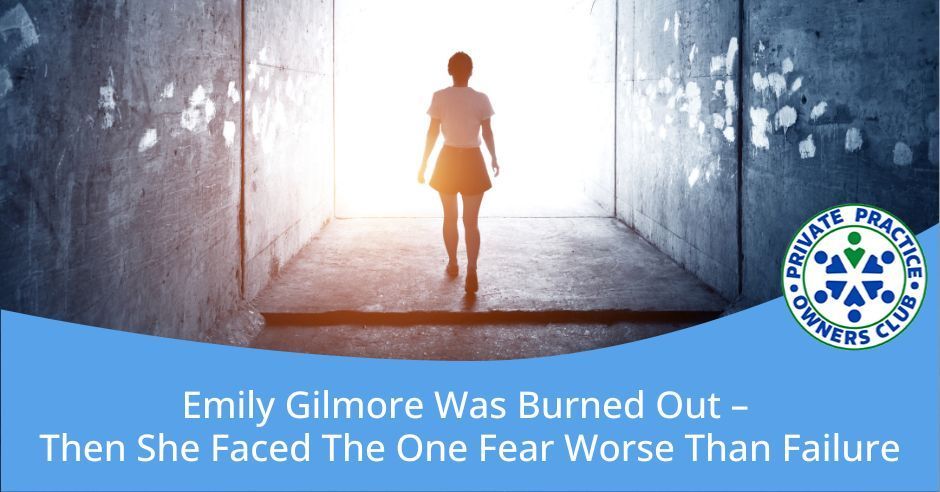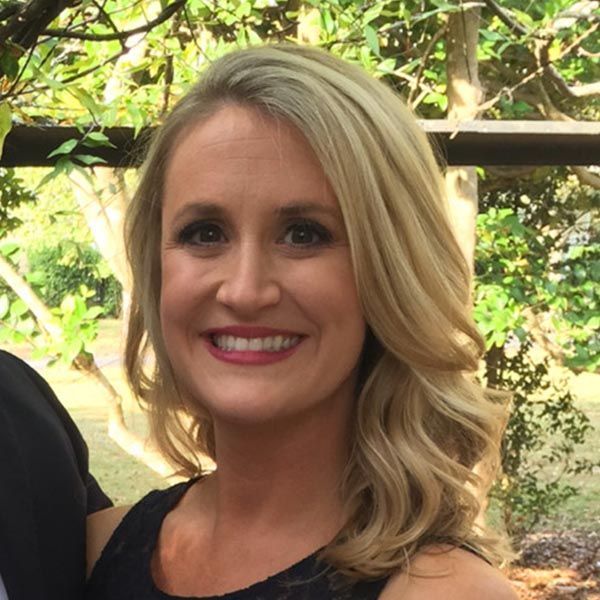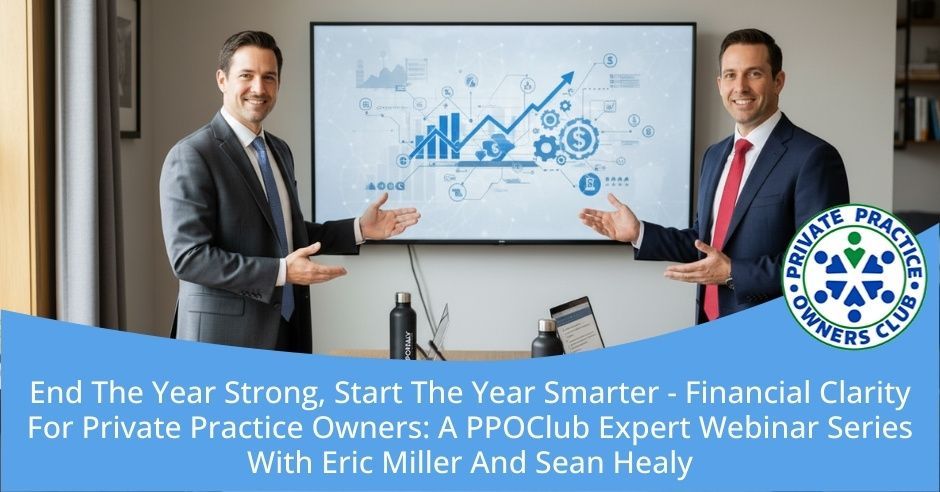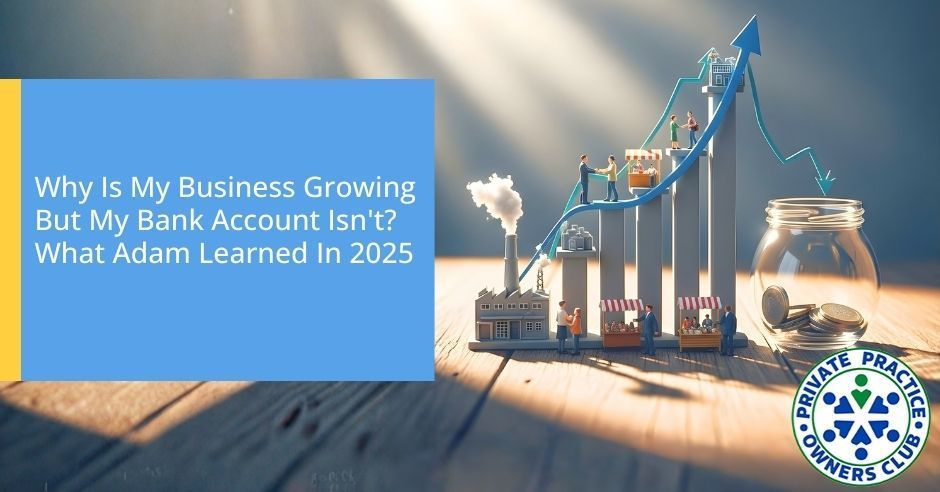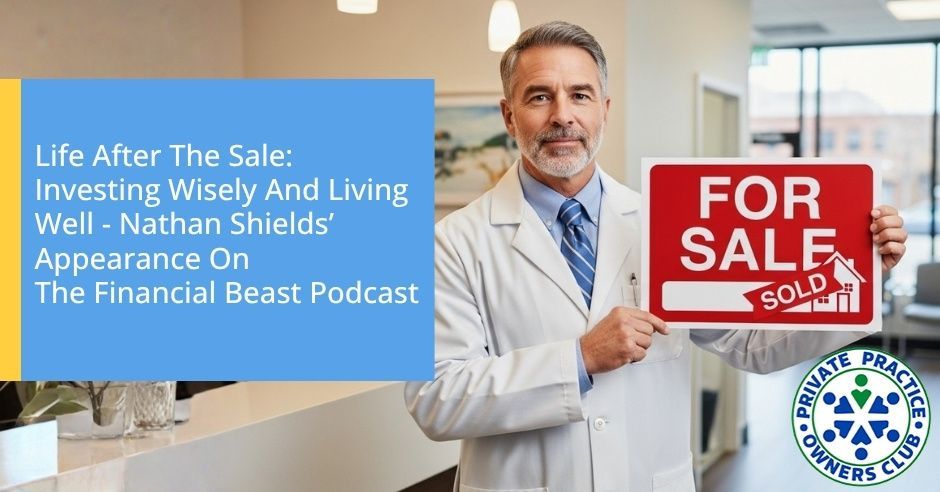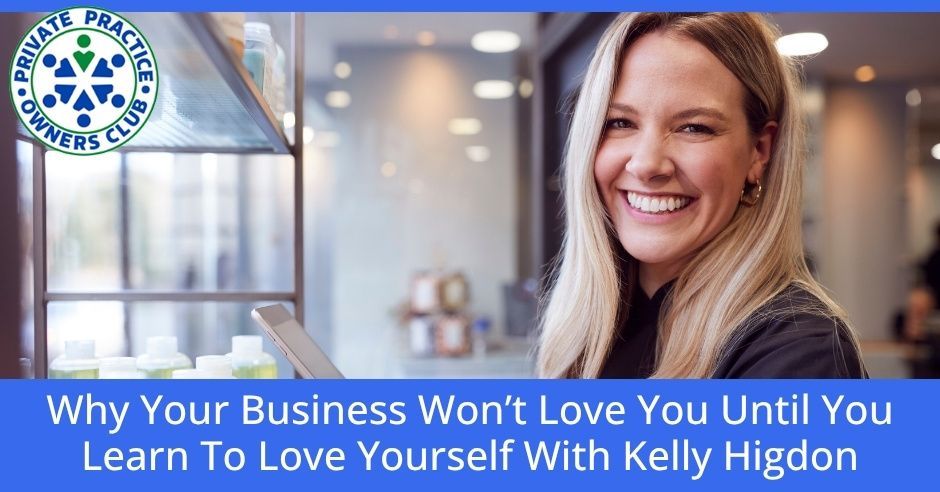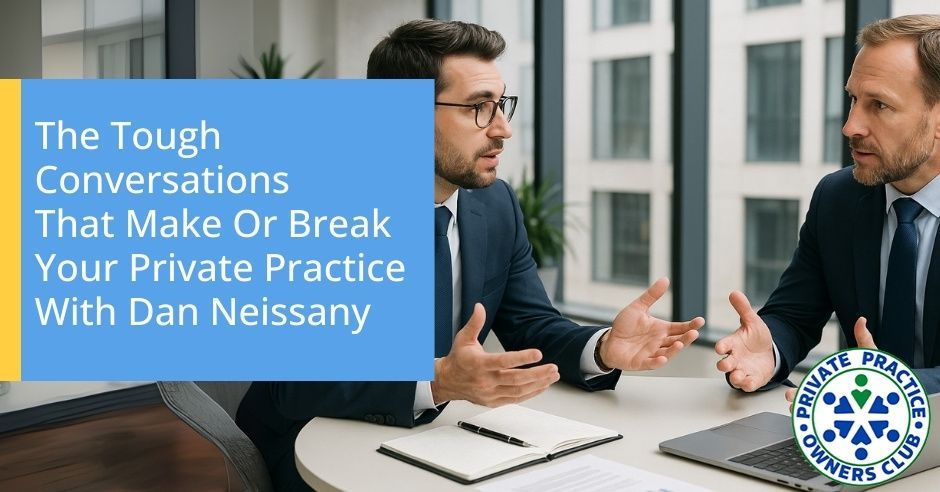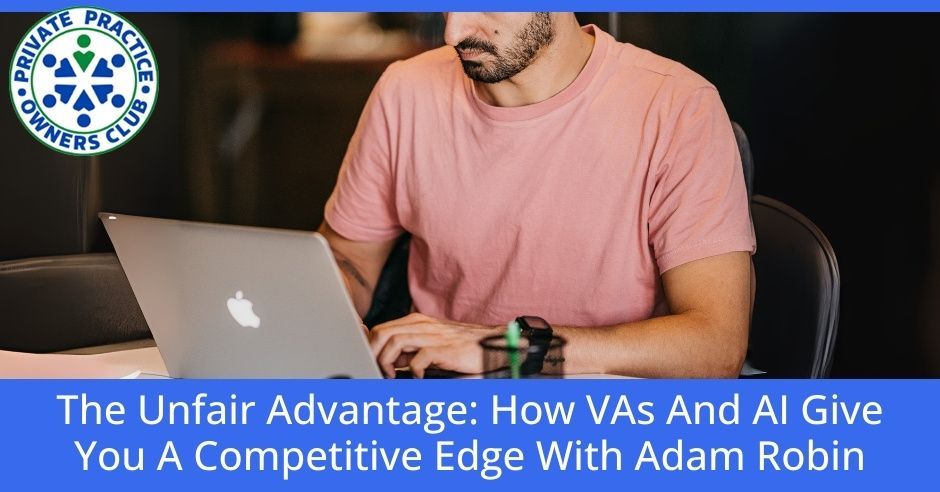Do you ever feel like your practice is running you instead of the other way around? That was
Emily Gilmore until she faced a brutal truth and made one move that changed everything.
Emily’s story is raw, real, and something every private practice owner needs to hear – especially if you're stuck, scaling too fast, or silently burning out. She built two booming locations during the chaos of COVID. But what most people didn’t see? She was barely holding it together.
After years of bootstrapping and overdelivering, Emily hit a wall.
This episode unpacks her turning point – what pushed her over the edge, the exact conversation that snapped her out of it, and how investing in herself became the catalyst for sustainable success. If you're scaling without systems or saying 𝒚𝒆𝒔 to everyone but yourself, this one’s for you.
Tune in and learn:
● Why staying too long in middle management nearly broke Emily – and what finally pushed her out.
● The real cost of trying to 𝑑𝑜 𝑖𝑡 𝑎𝑙𝑙 – and the lie she had to stop believing.
● How scaling her practice without systems nearly sank the ship – and what she did to fix it.
● The one truth she heard from Adam that finally gave her permission to invest in herself.
● Why leadership starts by getting crystal clear on what you need – not just your team.
𝗥𝗲𝗮𝗱𝘆 𝘁𝗼 𝘀𝗰𝗮𝗹𝗲 𝘄𝗶𝘁𝗵𝗼𝘂𝘁 𝗹𝗼𝘀𝗶𝗻𝗴 𝘆𝗼𝘂𝗿 𝗺𝗶𝗻𝗱?
Listen now and hear how Emily turned burnout into bold leadership—and how you can too.
Visit our Linktree for 𝗖𝗼𝗮𝗰𝗵𝗶𝗻𝗴 𝗦𝗲𝗿𝘃𝗶𝗰𝗲𝘀, 𝗙𝗿𝗲𝗲 𝗞𝗣𝗜 𝗗𝗮𝘀𝗵𝗯𝗼𝗮𝗿𝗱, 𝗙𝗮𝗰𝗲𝗯𝗼𝗼𝗸 𝗚𝗿𝗼𝘂𝗽, 𝗮𝗻𝗱 𝗔𝗻𝗻𝘂𝗮𝗹 𝗦𝘁𝗿𝗮𝘁𝗲𝗴𝗶𝗰 𝗣𝗹𝗮𝗻𝗻𝗶𝗻𝗴 𝗦𝗲𝗿𝘃𝗶𝗰𝗲𝘀:https://go.ppoclub.com/linktree-podcasts
𝗟𝗼𝘃𝗲 𝘁𝗵𝗲 𝘀𝗵𝗼𝘄? Subscribe, rate, review, and share!https://ppoclub.com/
---
Listen to the Podcast here
Emily Gilmore Was Burned Out – Then She Faced The One Fear Worse Than Failure
We’re going to talk with a Powerhouse PT named Emily Gilmore. Emily is a Physical Therapist. She’s the Owner and Founder of Thrive Physical Therapy
that was started in August of 2020, so a COVID Clinic. She’s located in Birmingham, Alabama. She has two locations. Emily started coaching within our program around December 2024 and I wanted to bring her on.
A quick story. I got on a call with Emily, a group coaching call and Emily started sharing her story. I hadn’t seen her in a while. I was like, “Emily’s, crushing it. She’s doing so good.” I was super impressed by the story, like how far you had come since the first time we chatted. I was like, “You need to be in our tier four group.” We’re going to uncover that story. Emily, welcome to the show. How are you?
I’m so good. Thank you so much for having me. I’m excited to share.
I’m excited to learn because I don’t fully know if I fully appreciate the story yet. I’m here to ask questions and uncover what shifted for you and through the story, we will peace out the nuggets. I’m trying to pull out the nuggets and wrap it up in a bow. That way, the readers can learn from your story and then, hopefully, achieve a little bit of success. Before we get started, tell us about you.
Emily's Journey: From South Alabama To Pelvic Floor Pioneer
My name is Emily. I’m from Birmingham, Alabama. I grew up in South Alabama, but moved here to go to UAB for PT school. I worked for a larger company for the first eight and a half years of my practice doing Orthopedics and about five years into my practice, I started incorporating more pelvic floor into my treatment as I was having children and understanding the impact of that with pregnancy and postpartum.
I became very interested in that, particularly postpartum rehab. It’s what started it because I recognized this giant gap in our entire profession addressing this cohort and it’s a big one. There was no real place that was set up for them. The treatments that we were giving them, in my opinion, were deficient and I couldn’t learn enough. It was my own struggles after having my children that spotlighted those issues for me and called me to ask all those questions. The place where I was working wasn’t set up for that.
In that eight-year mark, I ran into that burnout wall going 100. I was seeing a bunch of patients, drowning in documentation, and also not getting the outcomes that I wanted. That just was an unsustainable combination for me. I knew I had to make a move. I was at a weird life stage because my kids were 2 years old and 4 years old and had a lot of difficulty making the jump into my own practice. Thankfully, my husband is super supportive and extremely risk tolerant. It was basically like, “I’m not going to listen to you talk about this anymore until you make a move.”
In February 2020, I decided I was going to go out on my own then COVID hit. Everything stopped, which was discouraging. I was like, “I don’t know when I’m ever going to do this.” Someone told me, “At some point, the discomfort of staying will get worse than the discomfort of leaving and you will go.” I hit that point in July. It was just like, “I cannot walk through the store anymore. I got to go.” I started my practice in August of 2020. Since then, I have just rapid growth. I hired my first PT that December.
In ’23, I opened my second clinic and now we have 9 therapists and 3 admins in two locations. Rock and rolling. We're an orthopedic practice that specializes in pelvic floor and pregnancy and postpartum rehab, which was a very unmet match niche because it has blown up, which is exciting. It’s just rapid growth over the years. I’m a bootstrapper. I will put all the work in and do all the problems. Ultimately, what led me to you all was I stumbled upon your show.
Adam was always talking like, “If you aren’t doing, blah, blah blah. What are you even doing?” I’m like, “I’m not doing any of these things. I’m dumb.” I always had this mentality of like, “If I work hard enough, that’ll be fine. I can do it.” I will set the best example, see a million patients and do all the administrative things and be like, ‘I can do it all.” You can’t and at some point, something has to give and I knew that I was in this unsustainable place of seeing like 35 one-hour appointments a weeks and having about a half day for admin that half the time got covered up with kid’s stuff.
When I reached out to this group, once I was made aware that I wasn’t doing anything that they were talking about in the show, I was like, “I need some help.” I know that where I am, this can’t be it. Also, I don’t know how to get from point A to point B. Now the stakes are too high to get twelve people to pivot at the same time. It’s a little easier to make those tweaks when you have 2 or 3, but now that we have several locations, it’s a lot harder to get everybody to pivot and I was tired of making expensive mistakes because that is frustrating.
I wanted to feel like I didn’t have everyone on my bag charging uphill all the time. That’s what I felt like. When I reached out to you, I was exhausted and being like, “Am I doing all this so I can just pay exorbitant taxes and give up on my neck? It hurts too bad.” You don’t want it to be like that because you have this vision of what it would be like when you go out on your own or whatever. That’s never an easy road and there’s always hard work.
I knew that the way I was going about things wasn’t efficient and all of that was exponentially magnified by scaling. The problem with one location, they were manageable and I was so naive into opening that second location to be like, “I did this once. No problem. It’s like copy and paste. I’m just going to do whatever here on the other side of town. I’ll manage both while I continue to see patients full-time. This will be no problem.” It was a problem. We had some problems that were completely exposed by scaling without any good systems in place.
My favorite way of saying it is, when you open up a second location, all your problems double, plus commute.
That is the most perfect way to say that. I told one of my patients that. I was like. “This feels like having kids. You think having one more kid is not that much more. It’s just double work but it’s somehow way more than double.” The clinic was the same way. Two was exponentially more work than double.
The pull into the business is double as strong. The problems and the emotional toll is double. The cashflow of swings are double. The turnovers, the hiring need, the marketing, and the front desk issues are double. It’s like number two is a big deal.
That, I learned at that time. That is what the inefficiencies that I had with scaling. It was what tipped me over was. I was like, “I have got to find people ahead of me and they need to help me.”
That never stops. It’s not like I hire coaches and I’m still learning and so are you and so is everyone else who wants to grow and make more impact in their career. I do want to go back, though, because there were two things that stood out to me. One time you said, at one point you were burnt out in your original job. You said that you got to a place where you had to make a move. How did you get there? What was going on inside of you that made you feel like you had to make a move?
Escaping The Cage: When Corporate Life No Longer Fits
I was in mental management. I was a clinic director and had been that way for six and a half years. I had this realization that I’m going to be in the exact same place in ten years up against the ceiling and I was going to have to ask for approval, for birthday cakes, and lunches. I wasn’t going to be able to pick the staff I wanted. I just started to feel like a caged animal and I probably have some personality characteristics that doesn’t like to be managed.
I had to put up with that when I was younger but then I got to this place where I don’t have influence over anything that matters like picking my staff, developing my team. Whether or not people get bonuses or not, there was like no discretionary judgment on that. It was, can I buy lunch for them or not? I still had to ask for that. The direction that I wanted to move in to was this different type of women’s health treatment. It was like high level orthopedically focused. It was just like, this isn’t what we do and I’m like, this is what I want to do.
I am sacrificing my family. I’m exhausted. I’m working all the time to build someone else’s dream and I’m done. For what? I’m going to quit and they’re going to replace me. I am doing all this for their dream and not mine. I can’t even have it the way I wanted to because that’s not what they do and that’s fine. They have a different model but I can’t be in this model anymore.
I need room to spread, evolve, and pick the paths I want to go without falling into their corporate guidelines, which worked for me in the beginning and it stopped working. I needed more space to be free, to evolve, train other people and to move in the direction that I wanted to. Honestly, just seek sustainable practice in a way that I could continue to practice long-term and do what I wanted to for my family, my staff and do it the way that I wanted to.
For those that are reading, I only bring people on this show that are interesting. The reason why I brought Emily on is because she’s on a purebred entrepreneur. You don’t have to agree with me but I talked to entrepreneurs a lot more than you do. I’m telling you, the way that you think is incredible. I wrote down fear of regret. You had a fear that ten years down the road, you were going to wake up and realize like, “I didn’t reach my potential. I didn’t go all in on what I told myself I was going to go all-in.” Whatever that is inside you that’s telling you’re meant for something more. You didn’t want to have to face that person in ten years and say like, “I didn’t go for it.”
Especially in being in the same exact place. I’m going to wait ten years and be in this same exact place in middle management having the same frustration but have wasted more time and now, I’m older.
Fear Of Regret: The Driver Behind Entrepreneurial Leaps
That is the same driver that I had when I stepped into coaching. We’re going to get into that conversation in a second but I was terrified to hire a coach. I was telling myself a similar story. I’m like, “I’m running my business. I can’t do this. I can’t keep doing this. This isn’t going to work. This isn’t sustainable.” I felt trapped.
The problem was I had my own cage this time. I remember hiring Nathan and looking at him and be like, “You want me to pay you what and you’re going to do what?” I didn’t even fully believe it but the fear of regret and having to continue to do what I’ve been doing was more than the fear of like trusting the process and I’m so glad I did. Whatever that is, I don’t know if we’re driven by insecurity or achievement or whatever it is, but I find that entrepreneurs that have that inside of them typically do well. We’re internally motivated for some reason.
I knew I needed to make improvements and I was seeking this accountability. I wanted this accountability and feedback for from my staff to help direct me with that. I realized I’m not going to get that from them because I’m their boss. There’s always going to be this layer of like, they can’t be fully honest with me about all the failures that is happening and whatever my management style is because I support their livelihood.
At some point, the discomfort of staying will get worse than the discomfort of leaving.
I put an unrealistic expectation on them that like, “They can get this to me and they can’t,” because there’s always going to be that barrier there of like, “I can’t tell her that what she did suck because she’s paying me.” Tracy will be like, “That doesn’t work.” I’m like, “Thank you. I needed to hear that.” It was interesting because, Adam, you know, you closed the call. I had the discovery call with Nathan and I felt just heard because you want to feel like your story is unique but then you’re like, “I’m an overwhelmed operator like everyone else that reaches out to you.”
It’s weird because I invest money into continuing ed for my staff and have no problems about doing that. I want to continue to invest in their learning. I want to be the best and well-developed on the edge of technology buts I had trouble pulling that trigger when it came to my development. I was totally on board for their development but then I had a lot of hesitation of like, I wasn’t worth and investing in or I have no money investing in me.
I was in that space when I was talking to you, it was like, I can’t pull this trigger for me. I would do this for them but I can’t do it for me. It felt selfish or something. It’s weird and then you said, “Let me be crystal clear, you are the problems. It is your lack of vision and organization structure that has created this environment that you’re drowning in. It’s not going to get better until you invest in you.” That hit on. It closed the deal.
It’s a high risk, high reward.
I needed somebody to be like, “Let me be clear, you’re the problem.”
That’s one of the things where it’s like, if this lands then she’s the right fit for us and if it doesn’t, she’s not the right fit for us. I want to hit on this. You said, “I’m not sure if I was worth investing in.” I feel that.
That’s the root belief.
I feel that big time.
It’s like you want to invest in everybody around you and that feels good, comfortable, and growth for them but then like pulling the trigger on investing in growth for you was so much harder to commit to even though I easily spent that much money year over year on everybody else’s stuff.
Have you met Claire Delcambre in our program? She’s just like you. She’ll be on the show next, but we had a powerful conversation and this is a transformation that I see in a lot of owners. I feel like you and I have both experienced this but we can’t see the vision. You can’t see the vision until you first recognize what you need. You can’t see it because in the beginning, you’re only focused on what everybody else needs and wants. Therefore, you can’t hold them accountable because you can’t communicate what you need from them.
You can’t lead them because you turn into this weird like stalker micromanager person and you’re just weird. This is what I want you guys to write down. Whenever you stop focusing on what everybody else needs and you start focusing on what you need and asking for it. Things will shift. It’s like, I need this. This is what I need from you. Once I get what I need, I feel like I can get what I want to go. When you make that shift, you start leading people differently.
I feel like I suspected that there was a trickle-down effect. You’re the captain of the ship. I suspected that when I was discouraged, I could see everybody starting to get that way which then felt, I projected onto myself this exhaustive expectation of like I have to be up all the time because as soon as I get down, everybody gets down. I’m like, “I want to be down sometimes. Why can’t I just be down sometimes?”
I was like, I can’t afford to have these discouraged and burned-out seasons that go on without solutions to make them stop because the trickle-down of effect of that was significant. I didn’t know how to turn it around but, I also was exhausting myself trying to falsely prop myself up all the time with basically inflatable pillars. Nothing made of stability that could whether any storm. That was the biggest turning point for me was.
I can’t keep doing the same thing and expecting it to be different and be frustrating but it’s not. I got to change the way that I’m doing stuff if we expect any change. It’s just interesting, those like great beliefs of like, I’m not good enough or whatever. They just manifest themselves in different seasons of life all the time.
The Overwhelmed Operator: A Common Story Of Growth
Those are that are reading, here’s the next nugget. I’m sharing this because I have this conversation every day. Here’s the application process. Can you get a clinic open with some patients in the door and a couple people on your team? Can you have a little money left over at the end? If you can do that, you’ve already proven that you’re willing to do the work and you’re willing to make the sacrifices. At that point, you are worth investing in, period. That’s the entry. That’s, “Congratulations. You did it. You got here through hustle and will.”
You’re crazy enough to do this. Therefore, invest in yourself. Now, if you call me or a coach in your life, “I can’t figure out how to work on a Saturday every now and then.” Probably, don’t invest in yourself yet. Figure out how to work hard. You just don’t know how to work yet. You did it. I remember being on the phone with you and you were like, “I have two clinics. I got a team of like fifteen people and I’ve never had coaching. I don’t know what to do.” I’m like, “Emily, you’ve exceeded the application. You’re worth it.” I bet on that horse every time.
I’m like, “I’ll do the work. I’m a hard work. I love to bootstrap. I’m too a fault to bootstrap myself into the ground,” which is a problem but then I’m like, “My boots are all the way up. I need more tools.” It’s that same part that you reach for were you’re like, “I know I could be. I know I’m missing something and I am too in it to see it. I need help developing the tools so that I can manage things differently.”
For sure. You just need some skills. You’ve already got the work ethic. Now you just need to get some skills and it’s a wrap. The call that we had I remember, for those who you that follow my content. I’m sitting in my garage about to work out and Nathan’s like, “I got off the phone with this lady named Emily and she’s a killer. She’s perfect for the program.” I got on the call and I was like, “You need to be in this program.” It was very apparent. You were flustered on the other end of the call.
You would gotten to a place where you were like spinning. You were spinning and I was just trying to pull you back down and be like, “Listen to me.” You ended up doing it. I’m assuming it because at the end of the day, you realized like I can’t keep doing this. You were feeling regret but you made the commitment and you literally transformed things.
Transformed. The other thing that I would suggest just like me and knowing myself, I decided to commit to six months up front. It’s like anything. If you pay for it multiple months in advance, you’re like more accountable to do the work.
Once you pay, you pay attention. That’s what I like to say.
I was like, if I pay and I feel the like, “Oh,” of this initial out of cash. I am going to be committed to doing it for no other reason than, “I freaking already paid for it so I need to do it.” I was worried about with life and stress or whatever that I would be like, “I got to cut expenses.” I didn’t want that because I wanted to give it a fair shake because I thought like you all understood where I was coming from even though a lot of the things that were initially suggested, I had zero systems in place.
Everything was in my brain. I make up stuff when I went. I didn’t have any handbook. I had within like 2 or 3 months cultivated a leadership team or other people were reporting to people and not just me. I had no structure for that. I had a structure for performance reviews and a little bit of bonuses, but nothing was super effective or incentivizing. My lack of systems was 100%.
When you think about the daily grind, that did not feel important to me. I was like, “I need to freaking see patients. We need to reduce costs of the session. I need to market to this person. What are we doing on social media?” You’re like, “Do you have any systems in place? I’m like, “We don’t.” “Did you hear me when I said what we’re doing?”
You need more new patients.
“We’re going to marketing.” You all kept telling me, when you have the structure in place and you get stuff out of your head and wrote to paper, everything will get easier. That seemed a little too good to be true and I was like pretty skeptical but I was like, “I’m freaking paying for this. I’m going to do it.” Tracy helped me prioritize which things I needed to start with because it’s also like, I haven’t done these 1,500 things. It all feels so overwhelming, so I’m just not going to do any of it and focus on the daily grind that I know I can do.
It's like, “This month, you’re going to crank this out. I’m going to be checking on you. You got to have it done.” I set up a company-wide meeting at the end of February, and I was like, “I have to have all the stuff ready by then and told them I would. We’re going to be going over roles and responsibilities the handbook, cranking out a new bonus structure, blah, blah.” On the show, you were talking about the importance of off-site meeting. I took my two other people on my leadership team, my clinic director of my other clinic and my advent director. We left for two days and we went to the lake.
It was quiet and cold. We couldn’t do anything else and we talked about everything, roles and responsibilities, who’s in charge of this, what are our core values, what is the mission statement, how do we want to find this, this and this. Wrote it all down and gave me a framework. I had about 60 days to clean it up before I presented to everybody. I was like, “Deadline, finish it.” I’m on my computer the night before. I assembly our binders the night before. It was a tight finish but having that accountability for myself of like, I will present this to myself on this date and I have to have it ready.
Once you pay, you pay attention.
That was something that they were so craving. The people that were had been with me for a few years, they were completely shocked. I was like, “Look at this binder.” They were like, “I never thought this day would come.” Organization, detail and system creation is not my strong suit. I’m more of a visionary and less of organizational executor. That exposed that, but then I was like, “I don’t have a choice. I have to get this done. We need consistency. Stuff has to be fair across locations.”
I can’t even remember what I tell people when they asked me questions and I need to like, “You reference this.” In traction, they say, when everyone’s accountable, no one’s accountable. That sentence changed the way that I viewed. I was like, “I have to define these and who was responsible for them and what things fall into these umbrellas.” Otherwise, I have no structured to hold anybody accountable for. Taking the time, as you call it, the necessary boring stuff. I can’t emphasize how important that was and it was four years. I still look at it all the time. I’m like, “What did I say for this bonus structure?” I have to go back and reference it. I can’t remember.
That has made everything infinitely smoother. The second thing that was the biggest turnaround was goals. I had never set goals ever for my staff. We had some goals in regards to schedule efficiency as far as the percentage of appointments that are scheduled. I tracked that, but as far as visits per month, per quarter or per year of what we needed to hit certain benchmarks, had never done that. Again, I worked with Tracy to work backwards on the sheets that she gave me and set goals for the first time ever.
She told me and this has been the best advice ever. She told me to get an elementary school thermometer fundraising visual cue. Those thermometers that you like fill in and the raising money. We blow out the top of the thermometer. She was like, “Get one for each clinic. You have quarterly on one side. You have annuals on the other.” We were tossing out ideas of like, what is it going to take to incentivize people? Some of the incentive was like a little tough and now I realize, it was tough. People weren’t feeling motivated and incentivized. 1) It’s because they did another goal. 2) I wasn’t giving them any stats about how they were doing about that. 3) They were paid out so far quarterly. None of it was motivating.
I restructured that and define it. I was tossing out ideas in my head of like, “What should I get them if they blow out the top of the thermometer?” I decided I need to just ask them what they want. I held up at the moment her and I’m like, “This is quarterly. This is annually. What do you all want? If you blow out this thermometer quarterly, what is going to make reaching that goal fun, worth it, and incentivizing to you?” Do you know what they said? Hoka’s. They want tennis shoes. I should have know.
It’s everybody. Admin and PTs gets some shoes. I was like, “You bust out the monitor out four times, you get 40 pairs of Hoka’s.” Who doesn’t want those? It’s interesting and a huge lesson for me was ask. If you’re having trouble incentivizing your staff, ask them what they are incentivized by because I would have never guessed tennis shoes. It has made the biggest difference. Number one, we update that thermometer every week so they get to see it changing every month.
I’m like, “This is how many we have to get.” By April, they reached it with four working days and hit 113% of the goal in one month and close the Q on deficit. They have an annual incentive too. If everybody corporately collectively reaches the goal, they want to go to the spa. I’m like, “We’ll do it. Go to the spa, whatever services you want. If you all up at thermometer, we will take a day of R&R and go do it.”
Systems And Leadership: The Key To Exponential Growth
You’ve done so much. You’ve blown through, because not only did you get your systems in place but you started leading your team. The leadership principles clicked as well for you. It’s just so amazing.
The leadership was so much easier once I had a baseline of accountability because I was so far on the support end of the spectrum and then getting frustrated sometimes that there wasn’t always the urgency.
How did you do that? How did you overcome? This is important. I’m asking that because a lot of people struggle with that. They’re all on the support side of things and they don’t know how to challenge their team appropriately without being a jerk.
I do think it helped that I already had those support systems in place because I care about culture and supporting my staff. That trust and rapport was there with them. That made it easier to increase some of the accountability. Also, I leveled with them like a year review. We’re up on cost for visits across the board and it’s no one’s fault but it is supplies, taxes, and expenses. It’s all these and you all like seeing patients one-on-one and I don’t want to compromise that either, especially with our patient population. If we’re going to make this work, it has to work better and this is how we need to do it.
None of them are resistant to them. They were craving this communication for me on a more consistent basis because sometimes we get to annual reviews. There could be certain expectations and weren’t always aligned. There can be some of those that were a little bit harder in regards to annual raise, expectations and things like that. Maybe they were expecting something and that’s not what I was anticipating. There’s a little bit of a misalignment there that we both leave like, “Ew.” I don’t like that either because I also want sustainability, excitement, culture, and engagement in the company and skin in the game. When Nathan explained to me the support challenge axis, that resonated with me.
Explain that for people.
On one X axis, you have support and on one Y axis, you have challenge. If you go too far to the support side, you get some like, “That’s fine if nobody comes during this cancellation or, whatever. I want to leave on Friday. It’s okay. She’s fine with whatever.” If you get too far on the challenge aspect, you’re an ******* and nobody wants to work for you because there’s no appreciation, gratitude and support. It’s just like we’re work, this is your job, go home. There’s none of that culture like, I’m involved or I’m integrated in a team.
I felt like I was too far to that support side, but didn’t know how to get back to thread the needle. I explained that axis to them on a graph. I was like, “This is what it is. Here’s where we are. Here’s where we’re going to be and here’s what happens in the middle raises, bonuses, and more fun things you all like to do. This is margin and this happens when we reach goals. I understand that you all haven’t understood what your goals are because I haven’t given them to you. We’re going to do better about that.”
I recognize my own deficits in the vision that I cast for you all and we were over here because I was not giving you any systems for accountability. Here’s how we’re restructuring that. Essentially, restructuring it, I redid the bonus system so it was more tiered and paid out monthly. Most people are hitting some bonus every month, which has been incentivizing because before it was like one mark paid out quarterly. It’s like the end of the quarter way, “I forgot that I had a couple good weeks here and there.” It’s like, every month tiered. There’s more attainable tiers and high reaching tears that pay out. That’s helped a ton.
I am giving like monthly emails of their individual stats in one excel sheet of everything I track. I track like units per, visit visits per month compared to their goal, the percentage of arrivals, their benefits is based off percentage of arrivals, google reviews, community events that they participate in and social media posts that they do. I track all that one sheet. Screenshot at every month as they updated it with comments. “You did so good this month. This was strong or I feel like if you communicate a little better and pass, you could totally hit it.”
They’ve loved that because they feel like, “Finally, I understand where I am at in the year.” I send them theirs, the clinic that they’re a part of and the collective group so they have an idea about where am I in the bell curve with everyone else but without sharing everybody’s individual stats. It’s not like a live spreadsheet where you can see anybody’s stuff and then I have quarterly meetings.
Every quarter, I sit down with everybody individually. I’ll also use that time for individual mentoring so that if they want to learn about anything clinically, we can talk about that and have them bring a difficult clinical case that we can talk about, work on whatever skills they want to and review where they’re at for the quarter, three wins, three Ls, and what’s going to help you get to the other side.
That way, nothing is going to be a surprise come to the annual review and that has been exceptional feedback about that. In 2025, we also created like a work buddy system where everybody’s paired off together. They can go to lunch, get their nails done or whatever, once a month with a coworker, so that there is like a peer-to-peer outlet and source of connection that’s outside of clinical care. Again, foster that connectivity as a team.
A lot of those are like cross clinics. We’ll have like one person at one clinic buddied with another person on another clinic or maybe a younger therapist paired with one with a little more experienced just so there’s a little bit more of that team connectivity. That’s very important to my staff that they feel connected and engaged with each other. Not just with management.
You transformed your culture.
I would say we clean it up.
Two things that I heard there but it feels like when you tell that story, you got confident. You found clarity on what you needed and then you had the courage to speak it. Once you started seeing the line, you were like, “This is where we’re going with things. Now, I know what I need.” You are clear on what you needed.
I had never defined it and that was the problem. I had never defined it, much less communicated and much less given anybody any progress of how we’re doing through the year. That was so key. In fact, I told Tracy, I was like, “Things are running so smoothly, I feel uncomfortable.” There’s always been something.
“Something’s going to change. I’m going to shift something. I’m going to break something.”
There’s always something big that just happened or I need to recover from or I need to anticipate. I’m like, “Things are running so smoothly. It feels weird. Am I missing something?” My sweet husband was like, “You seem happy. I don’t know what you’re doing but just don’t stop.”
Isn’t that cool?
If you’re having trouble incentivizing your staff, ask them what they are incentivized by.
The crazy thing was, you all kept telling me to trust the process and the process wasn’t complicated. It’s like you need some direction about where to start and some accountability of like, “You said you’re going to do it. Where is it?” There’s a different level of accountability coming from a coach that you can’t get from your staff because their whole objective is push forward.
The Support-Challenge Axis: Finding Balance In Leadership
For sure. It’s just like you would do with your team. You’re listening to seek and find like I’m trying to move you forward in whatever direction that is. It takes a lot of cognitive listening as a coach, too. The same thing you do with your team. Let me tell you what I wrote down. I wrote down six things. For those who want to be more like Emily, you can focus on these six things.
Number one, we’ve got to tap into the thing that intrinsically motivates us, whether that’s fear of regret. For Emily, it was fear of regret. For you, what is it for you? Is it a fear of regret? Is it something that you want to prove? For your kids, is it something you want to build for your kids? What is it that intrinsically motivates you? Tap into your why. Tap into your purpose.
Number two, recognize that you are the person that’s worth being invested into. You got to like set yourself free of that. That’s why I always say, you deserve it. You are worthy. You are bold. You are in powerful and inspiring. When you believe that and you’re worth investing into, you will start getting clear on what you need.
Number three, you did a good job of holding yourself accountable on purpose on a few occasions. You pay up front for six months for coaching. You didn’t have to do that. You did it because you wanted to feel the accountability. You set the deadlines with your team. You’re like, “On February, blankety blank, I’m going to have the meeting.” You like to set boundaries for yourself.
I have to because I am like the essence of ADHD. If there’s not a little bit of feet to the fire, that’s more fun over there or maybe I could focus on this. For this necessary boring stuff, I had to. Otherwise, it would have never been done.
One of the things that I hear a lot of successful people say is, if you want to be successful, just do what you say you’re going to do. What I’m hearing is, you created this environment in which you had no choice but to do what you said you were going to do.
I eventually created that for the stuff I hate doing like setting things.
Exactly. You said you’re going to grow your business, go freaking grow your business. Stop being a loser. Number four, systems.
There’s just no substitute for it. I thought that they were lame and not important but I couldn’t have been more wrong.
Number five, setting goals and ideal outcomes with yourself and with your team. You’d sit down and be like, “What do I want?” Write that on the board and stare at until you figure out what it is and write it down.
I will also add to that. I explained to them why meeting these goals are important like, “I don’t like to be stressed out about the cost of expenses. I want to support the cultures where we hang out and we do Thrive hangs and we spend time together. All that comes with margin. If we don’t have margin, I’m not going to be able to give you the annual raises and the bonuses. I want to be able to do that stuff for you all. I want to create the system that can be successful for that where we can also do what we need to for our families, have sustainable practice and go to bed well with the type of patient care that we’re providing.” All that comes with that, “We have to hit these.”
Let’s solve the problem together.
I can’t do it by myself. I want these things for you, too. I want these for you as well. Explaining to them some of the some of the problems that I was facing.
Being transparent with them. Tell the truth like, “This is where we’re at.”
We all want the same things. None of that was met with resistance. They were like, “I know. I want to continue to treat patients one-on-one. I like having some flexibility with my schedule and I want to be able to spend some holidays with my kids.” We all wanted to say the same thing and justifying those to not just be like, “I want to get all the money,” which is never the case. I want this for you too and we have to work together to make this sustainable and this is how we can do it. They were they were in. They’re the sweetest, best, and the dream team. They’re the best and they have always been the best. The problem was me because I didn’t have the tools to tap into their potential like I could have.
The last thing I wrote down is ask your team what they want and stop trying to pretend like you know what they want like, “They want is money. All they want is this.” That’s all bull crap. Ask them what they want and they’ll be honest with you. I also put slash have explicit communication just like speak cleanly and authentically. Before we wrap it up, congratulations. It gives me tons of purpose. I’m just so happy for you. What do you feel like is next for you? Where are you and your team thinking about taking things as you go into the second half of the year and looking into 2026? How do you see things evolving for you?
That’s an interesting question and that’s one I’m tossing back and forth, so I don’t have a great answer for. I can appreciate with my scaling too early to zero systems in place. One of the biggest lessons I learned from that was that it has to be the right people in place at the right time. My focus is to clean up some training protocols so we can have more continuity across clinics as we add new people and focus on developing like future leaders.
To me, there’s no point and thinking about opening up another clinic if we don’t have leaders in place that are developed, trained and confident to step into those roles. Identifying who those people are, pulling them into training and developing them so that when we make that next move and I’m if it’s the right person at the right time and the right place, I will do it again.
When you have a lot of great people around you, the what should I do next, doesn’t get asked as much because it’s like, I have an amazing human being who’s so capable. I love being around them and they’re talented and skilled. Whatever they want to do is what we’re going to do. Let’s just do that. if they want to open a clinic, we’ll open a clinic. If they want to help recruit, we’ll recruit. Pour into your people and your people. Will Humpries may helped me realize this, “”All your opportunity comes through people.”
That’s the only thing it comes through.
It comes through people, so get good at building and finding great people. The opportunities just happen.
My focus next is who.
I love it. That’s a natural progression. You’re transitioning out of that over on the operator. You’ve built a team and now you’re getting into that evolved leader stage where it’s like, “I’ve got a team but now let’s build like a real leadership team where I could take off for six months.” These are all like, they could take my place if they want it to. You can grow and build an empire. Thanks for coming on. I’m very confident that you’re going to inspire at least one or two people who read this. If people wanted to reach out to you, hear your story, and get some advice. How would they connect with you?
Connecting With Emily: Advice And Encouragement For Women Entrepreneurs
They could definitely email me directly at
EGilmore@ThrivePTAL.com or they can message me on Instagram@ThrivePTAL. Send me DM. A little side piece, I want to encourage women too that I did this and went out on my own with two my kids. That seemed a little crazy at the time but no matter where you are in the stage of raising kids, you can do it and there is no substitute for being self-employed and having control over your schedule to do what you want to do in that regard. No plug there.
We’ll circle back another six months and see where you’re at then.
It sounds great.
Have a good one. We’ll talk soon.
Important Links
About Emily Gilmore



